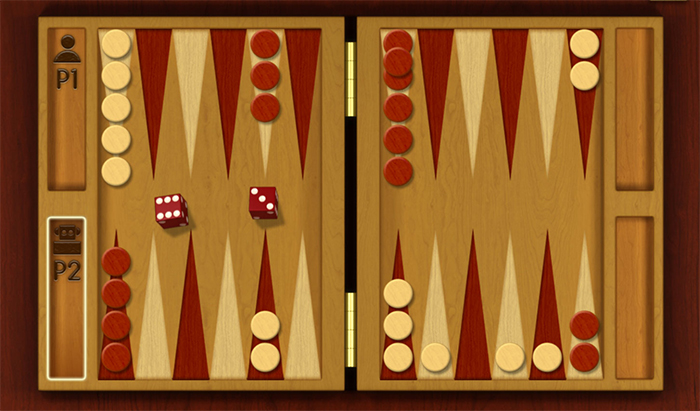Learn the Rules of How to Play Backgammon
Equipment
Aim of the gameEach player takes 15 men/checkers each and set them up in specific position. The players take turns to roll the dice before moving their men around the layout of the board. The aim is to get all of your men/checkers “Home”, the first person to get all of their men home is the winner.
How to rollTo determine who goes first, both players must roll the dice, the player who rolls the highest number will be able to move first. When taking a turn, a player must roll both dices and then move two checkers in accordance with what numbers the dices are showing. If a player manages to roll a double, for example the two dices show a 5, this is referred to as a Backgammon Doublet and allows the player to move 4 men/checkers.
Moving rulesThe roll of the dice determines how many squares a checker can be moved. These checkers can only be moved forward but only if there is no other checker on the square which their dice have determined they must move to, and also if there is only one of the opponents checkers at this point. The diagram below shows the direction in which both checkers move. When moving, a player can decide whether to move one counter or two. For example if the two dices show a 3 and a 6, the participant could decide to move one counter 9 squares, or the first counter by 6 and the second by 3 squares.
Hitting opponentsBackgammon hitting is when the participants checker rolls onto his opponents point. For example if an opponent is 3 squares away and one of the numbers from the two dices is a 3, this opponent will require to move his counter to the Backgammon bar to complete the course again.
Exiting checkers from the barWhen a player has some of his Backgammon counters inside the bar, the player must move these counters out of the bar before moving any of the counters which are currently in play. If an opponent is blocking a point which you have rolled then you must pass your turn. For example if you roll a six and your opponent is on the spot which you have rolled to.
Getting your checkers homeAfter a player has got all of the counters into the home-point, (as indicated on the image previously) the player can then begin to secure his players home. The first method of doing this is rolling the dice to the correct figure, for example if a checker is 5 places away from the secure section, you must roll that number. Checkers don't always need to be secured and can choose a different route if within the rules. Once you have secured a counter then that counter cannot be used again.
How to winThe game ends when a participant has successfully managed to get all of the 15 checkers safely home. There are 3 types of a Backgammon win. A single win is if you have managed to get all your counters home and your opponent got at least one counter home. A gammon win is awarded when you managed to get all of your counters home and your opponent failed to get any safely home. This is a dual win. A Backgammon win is the same as a gammon win, however they have a man in their home board or on the backgammon bar (The place where counters are sent after being hit). This is a triple win.
Backgammon CubeBackgammon is played for a stake per point, for example £1 per 1 point. In Cash games, the players will play several games and count the final result or they will play to an agreed total, such as first to 5.
Backgammon Cash GamesIn cash games there is a stake on the winner, whoever loses must pay the winner the stake value multiplied by the number which the cube lands on. Furthermore, If the loss was a Gammon Loss meaning the player did not have any checkers home, this value is then multiplied by 2. For a Backgammon loss the value is then multiplied by 3. The “Jacoby rule” is often applied in cash games. This rule means that a gammon or backgammon win can only count if neither player has proposed a double during the game. This enhances the games speed as players can avoid doubling to look for a gammon win. There are also some other rules which are sometimes applied if all players agree. Automatic Double - When both players throw the exact same number at the beginning of the game. The doubling cube is then doubled, however it stays at midpoint. Beaver - This rule is when a player doubles and his opponent believes he has the best chance of winning, therefore he can beaver the cube. This means that the player will take the double (not avoid it to try and go for a gammon win) but takes the cube on twice the value.
Backgammon Match PlayMatch play is the standard form of backgammon used in the competition environment. Both players agree on a number of points to score and play to that total. For example, first to 3 rounds. |


